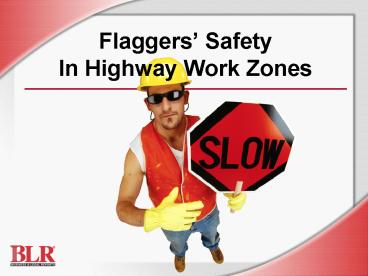Flaggers PowerPoint PPT Presentation
Title: Flaggers
1
Flaggers SafetyIn Highway Work Zones
2
Session Objectives
- You will be able to
- Recognize the hazards of flagging
- Identify different sections of a
temporarytraffic control zone - Understand the temporary traffic control plan
and your responsibilities - Use signaling devices effectively
- Position warning signs, tapers, and flagging
stations safely
3
Hazards of Flagging
- Risk from equipment and passing vehicles
- Statistics support high risk of injury
- More than 100 workers killed and 20,000 injured
each year
- More motorists than workers killed or injured in
temporary traffic control zones
4
Temporary Traffic Control Zone
- Advance warning area
- Transition area
- Activity area
- Termination area
5
Advance Warning Area
- Road users informed of work zone
- Warning signs longer on freeways
- Sign A1,000 feet from transition
- Sign B1,500 feet from sign A
- Sign C2,500 feet from sign B
- Drivers see sign C first
6
Transition Area
- Road users are redirected out of the normal path
- Mobile operations transition area moves
- Tapers are used to transition traffic
- Space taper devices properly
7
Traffic Tapers
- Minimum taper length L WS
- Merging taper requires longest distance
- Shifting taper is used where shoulder is closed
- Downstream taper is used in termination area
Minimum Taper Length Width x Speed
8
Activity Area
- Work space is for workers, equipment, and
material - Traffic space routes road uses through activity
area - Buffer space separates road user flow from work
space
9
Termination Area
- Returns road users to normal path
- END ROAD WORK sign
- Longitudinal buffer and taper
10
Temporary Traffic Control Plan
- Avoid abrupt lane changes
- Encourage alternate routes
- Schedule road work at night
- Provide adequate warning for motorists
- Using flagging to guide motorists
11
Routine Inspections
- Implement traffic control plan properly
- Monitor plan under varying conditions
- Keep channelizing devices clean andreflective
- Check for missing traffic control devices
- Look for evidence of near misses
12
Warning Signs and TapersTest Your Knowledge
- What is the recommended spacing for three advance
warning signs on a highway?
13
Warning Signs and TapersTest Your Knowledge
(cont.)
- How long should a taper in a transition area be
if the offset is 16 feet and the speed limit on
the highway is 55 miles per hour?
Minimum Taper Length Width x Speed
14
Warning Signs and TapersTest Your Knowledge
(cont.)
- What is the maximum distance in feet between
devices in this taper if the speed limit is 55
mph?
15
Temporary Traffic Control Zone Setup and
Inspection
- Do you understand
- What weve discussed about the advance warning
area, transition area, activity area, and
termination area? - The importance of routine inspections in
temporary traffic control zones? - What inspections should cover?
16
Criteria for Flaggers
- You are responsible for public safety and must
- Communicate instructions clearly
- Maneuver quickly
- Control signaling devices
17
Criteria for Flaggers (cont.)
- Understand safety traffic control
- Recognize dangerous traffic situations
- Know the traffic control plan
- Be identified as flaggers by motorists
18
Flagger Authority
- Monitor operations in the work area
- Communicate with traffic control supervisor
- Halt operations if hazard arises
19
High-Visibility Apparel
- Clothing meets safety standards
- Fluorescent background color
- Reflective materials
- Designed to identify as a person
- High-visibility armbands, hats, vests, gloves
- Inspect reflective material regularly
20
Alternatives to Flaggers
- Hazardous conditions (high traffic speeds, bad
weather, limited visibility) - Alternative traffic management systems (lane
shifts, portable traffic signs,remote signaling
devices)
21
Hand-Signaling Devices
- Control road users
- STOP/SLOW paddle
- Red flags
- Strobe lights on paddles
22
Signaling with Paddles
- Stop road users
- Direct stopped road users to proceed
- Alert or slow traffic
Image Credit California State Dept. of
Transportation
23
Signaling with Flags
- Stop road users
- Direct stopped road users to proceed
- Alert or slow traffic
Image Credit California State Dept. of
Transportation
24
Flagger Stations
- Road users must have sufficient distance to stop
- Errant vehicle can stop before entering work
space - Advanced warning signs
- Lighted at night
25
Flagger Stations (cont.)
- Stand on shoulder next to road
- Enter road only after vehicles have stopped
- Be able to warn workers of danger
- Stand away from shade and shadows
- Keep workers away
26
One Flagger
- Short traffic control zone
- Stationed on shoulder opposite work space
- Good visibility of traffic
- Traffic controlled at all times
27
Two Flaggers
- Flagger at each end
- One flagger is the coordinator
- Communicate with each other
Image Credit California State Dept. of
Transportation
28
Flagging at Night or in Adverse Conditions
- Wear highly visible clothing or rain gear
- Illuminate flagger workstation
- Use warning signs to reflect actual work zone
conditions - Do not attempt to perform any other duties
- Do not use devices such as cell phones or pagers
29
Match the Traffic Direction With the Hand Sign
SLOW
- Stop
- Proceed
- Slow down
STOP
SLOW
30
Flagger Safety Procedures
- Do you understand
- About flagger qualifi-cations and authority?
- About high-visibility apparel and alternatives to
flaggers? - About signaling devices and flagger stations?
- When one flagger is sufficient and when two are
required?
31
- Make sure you understand your responsibilities
and authority - Be familiar with the traffic control plan
- Wear high-visibility clothing
- Inspect signs and devices regularly
- Position your flagging station properly
- Use clear signals to guide traffic through the
traffic control zone

